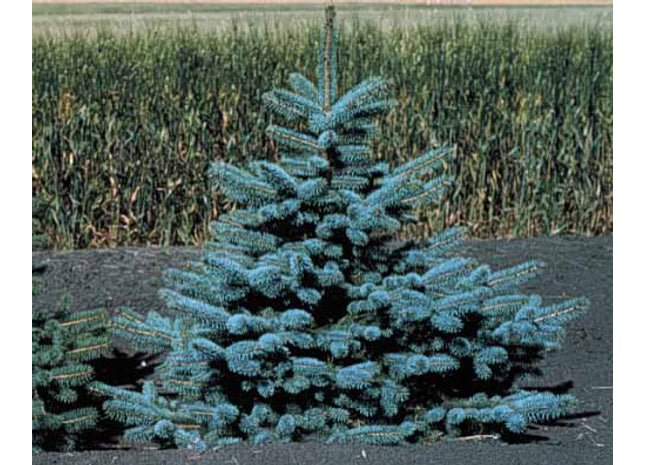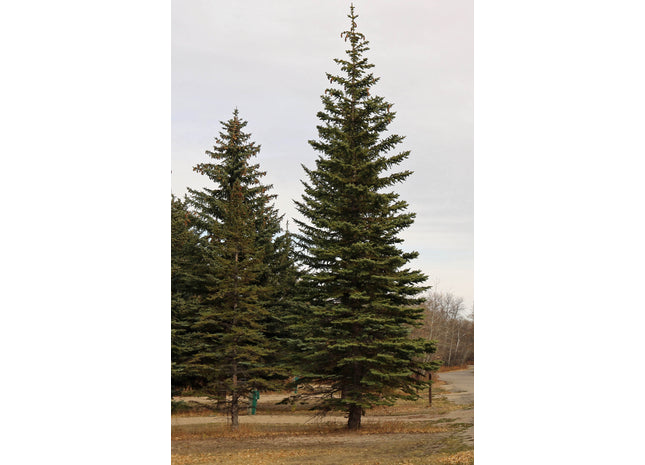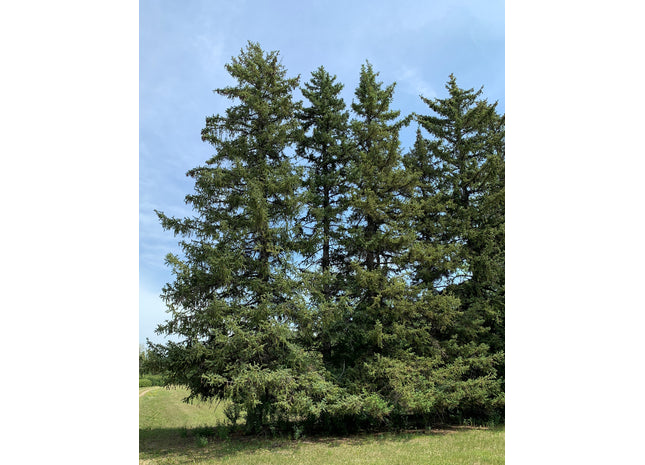Spruce

Agroforestry Solutions 'Cram' Colorado Spruce Seed
Latin Name: Picea pungens DESCRIPTION Family: Pinaceae Native Range: Native to Rocky Mountain region of United States Seed Source: Colorado spruce in a seed production orchard near Indian Head Saskatchewan. Height and Spread: 18m x 8m Overview: The 'Cram' seed strain was developed specifically for agroforestry planting in non-boreal regions. This seed strain is characterized by a high percentage of silvery-blue needle coloured seedlings, an upright crown form, cold and drought hardiness, and adaptability to a wide range of growing conditions in the aspen parkland. The strain was named in honour of Bill Cram, Indian Head Tree Nursery superintendent from 1958 to 1978. Seeds: Dark brown, winged 2-4 mm long. Average number of seeds/packet: 1,150 SEED TREATMENT / SOWING Stratification: No stratification required. Water soak 24 hours before sowing. Ideal sowing time: Spring; Non-pretreated seed outdoors in May. Sowing instructions: Sow 1.0 cm deep, 50 seeds/meter; Greenhouse - sow 3 seeds per cell. Growing conditions: 'Cram' Colorado spruce grows on a wide variety of soils but favours loamy soils with a pH of 5.0 to 7.0. It is shade tolerant but grows best in a sunny exposure. Agroforestry Value 'Cram' Colorado spruce is used in farmstead shelterbelts. The dense shallow roots make it useful for soil stabilization and erosion control on moist sites. Its dense coniferous crown provides excellent habitat for songbirds and thermal cover for mammals. The silvery-blue foliage makes this seed-propagated cultivar aesthetically pleasing.
$20.00 - $25.00

AgroForestry Solutions 'Harry Lennox' White Spruce Seed
Latin Name: Picea glauca DESCRIPTION Family: Pinaceae Native Range: Native to boreal region of Canada Seed Source: Seed production orchard near Indian Head Saskatchewan. Height and Spread: 18m x 5m Overview: The 'Harry Lennox' seed strain is excellent for agroforestry planting in non-boreal regions. It is characterized by an upright crown form, extreme hardiness, and adaptability to a wide range of growing conditions in the aspen parkland. The seeds train is named in honour of Harry Lennox, tree planting supervisor a the Indian Head Forest Nursery Station in the early 1900s. Seeds: Dark brown, winged 2-4 mm long. Average number of seeds/packet: 1,600 SEED TREATMENT / SOWING Stratification: No stratification required. Water soak 24 hours before sowing. Ideal sowing time: Non-pretreated seed outdoors in late May. Sowing instructions: Outdoors - sow 1.0 cm deep, 50 seeds/meter; Greenhouse - sow 3 seeds per cell. Growing conditions: 'Harry Lennox' white spruce grows on a wide variety of soils but favours loamy soils with a pH of 5.0 to 7.0. It is shade tolerant but grows best in a sunny exposure. AGROFORESTRY VALUE 'Harry Lennox' white spruce is used in farmstead shelterbelts. The dense shallow roots make it useful for soil stabilization and erosion control on moist sites. Its dense coniferous crown provides excellent habitat for songbirds and thermal cover for mammals. Excellent wood quality for lumber.
$20.00 - $25.00

AgroForestry Solutions 'Norman Ross' Norway Spruce Seed
Latin Name: Picea abies DESCRIPTION Family: Pinaceae Native Range: Native to western Europe to the Ural Mountains Seed Source: Large specimen trees planted in the early 1900s at Indian Head Saskatchewan Height and Spread: 18m x 7m Overview: The 'Norman Ross' seed strain is excellent for tree planting in non-boreal regions. It is characterized by central branches which spread horizontally and smaller drooping branchlets attached to them. There are a number of mature trees of this strain over 100 years old in the town of Indian Head, Saskatchewan. This seed strain was introduced by Norman Ross, Superintendent of the Dominion Forest Nursery Station from 1901 to 1941, from Europe in the early 1900s. It has proven hardy and adaptable to a wide range of growing conditions in the southern prairies. Seeds: Dark brown seeds oblong at base 4 mm long. Average number of seeds/packet: 500 SEED TREATMENT / SOWING Stratification: No stratification required. Water soak 24 hours before sowing. Ideal sowing time: Non-pretreated seed outdoors in late May. Sowing instructions: Outdoors - sow 1.0 cm deep, 50 seeds/meter; Greenhouse - sow 3 seeds per cell. Growing conditions: Norway spruce grows on a wide variety of soils but favours loamy soils with a pH of 5.0 to 7.0. It is shade tolerant but grows best in a sunny exposure. AGROFORESTRY VALUE 'Norman Ross' Norway spruce can be used as specimen or shade trees on larger properties or farmyards. Its dense coniferous crown provides excellent habitat for songbirds and thermal cover for mammals. Excellent wood quality for lumber.
$20.00 - $25.00

AgroForestry Solutions 'Kabalin' Siberian Spruce Seed
Latin Name: Picea obovata DESCRIPTION Family: Pinaceae Native Range: Native east from the Ural mountains to the Sea of Okhotsk Seed Source: Specimen trees, near Indian Head Saskatchewan. Height and Spread: 15m x 7m Overview: The ‘Kabalin’ seed strain is excellent for tree planting in non-boreal regions. The tree typically has a single round straight trunk and a pyramidal to narrowly conical crown. This seed strain was introduced from the forests near Novosibirsk Siberia in the 1980s. It has proven hardy after 35 growing seasons in southern Saskatchewan. It is named for Sergei Invanovich Kabalin, from Novosibirsk, Siberia who helped with the collection of this seed source. Seeds: Dark brown seeds oblong at base 4 mm long. Average number of seeds/packet: 600 SEED TREATMENT / SOWING Stratification: Soak in water for 24 hours then stratify for 30 days in moist sand at 5°C. Ideal sowing time: Sow stratified seed outdoors in late May or non-stratified seed in early September. Sowing instructions: Outdoors - sow 1.0 cm deep, 50 seeds/meter; Greenhouse - sow 3 seeds per cell. Growing conditions: Siberian spruce grows on a wide variety of soils but favours loamy soils with a pH of 5.0 to 7.0. It is shade tolerant but grows best in a sunny exposure. AGROFORESTRY VALUE 'Kabalin' Siberian spruce can be used as specimen or shade trees on larger properties or farmyards. In Siberia it is an important timber tree. The needles are sometimes used by locals to make spruce beer. Because of its hardness and flexibility, its wood is used mainly for flooring. Its dense coniferous crown provides excellent habitat for songbirds and thermal cover for mammals.
$25.00




